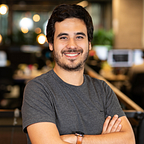What we talk about when we talk about collaboration
At SumUp we believe that teams come first, breaking silos and empowering autonomous groups of people to deliver value to our merchants worldwide. This also translates into how we approach collaboration and design processes that foster group thinking.
Our ever-growing product design team has now more than 30 designers scattered across different offices and squads. As we grew in scale, new challenges emerged but collaboration continued as a strong part of our process, learning together on how to adapt in a hyper-growth environment. This article summarizes a little bit of what we learned and how we approach collaboration in the product design process, from problem definition to implementation.
Sharing responsibility while defining problems
A key part of our process is understanding what problem we are trying to solve and generating insight with our merchants. Research happens across disciplines and is understood as a team responsibility, where engineers, product managers, researchers, and product designers act together to move the process forward. Even though design might lead this movement, we try to build opportunities where the team helps define the problem space.
One example is how we facilitate research synthesis. Carolina Alves, a product designer at the lending squad, had the challenge to understand how a new market would react to a cash-advance solution. Especially with the COVID-19 crisis, we knew that a lot of our merchants were struggling with decreased income and wanted to quickly explore possible opportunities to help them during this scenario. After a series of interviews where team members were also part of, the work of synthesizing what was learned did not belong solely to her. On the contrary, she facilitated a session with the squad and business stakeholders where everyone surfaced together with the data that was generated and transformed it into product opportunities.
Bridging product gaps across teams
Even with a well-defined problem, the way you approach possible solutions might also greatly benefit from the power of collaboration. However, as the organization grew, we were struggling to deliver solutions to problems that encompassed more than a squad. We then stumbled upon the challenge of how to drive collaboration across different teams.
One example is the purchase flow on one of our main acquisition channels and how potential merchants were struggling to join SumUp. We knew that there were several problems in the journey, based on both quantitative and qualitative evidence, but struggled to make any solution a reality. Our decision was to go back to basics and gather diverse representatives of each team in the same location.
As a global tribe that is half in São Paulo and half in Berlin, the decision (before quarantine times) was to hold a workshop in Germany. We spent practically one-week building the same understanding of the problem together with marketing stakeholders from major markets and transforming this into a purpose that explored possible solutions. Following this, we validated with non SumUp merchants as part of the agenda as well. With a clear vision, we were able to plan what we needed to do and prioritize between different teams and after more than one year we were able to experiment with the flow again and begin to solve those cross-squad challenges.
Empowering individuals to support each other
In the end, running parallel to the process are individuals trying to give their best. The product design community within SumUp is one of the main responsible for giving me energy, challenges, and inspiration for my work. To achieve this we experimented with a couple of different ceremonies where we could share work but we eventually realized that we needed to go a little deeper to actually collaborate together instead of just showing and telling. This led to a weekly longer co-design session that we run by tribe (involving multiple squads). There, we have a safe-to-fail environment where the idea is to crack our brains together as product designers to help each other, no matter where we are in the process.
Another example is how Francisco Oliveira, a product designer that was working in the referrals squad, together with his team, realized that they needed to do a step back and guarantee that they knew what they were aiming for as a product team. They got together (also in pre-quarantine times) and spent a day getting to know each other better as teammates and using that connection to build together their product vision. In that sense, we also believe in the potential that designers can have in helping a team build connections.
Stories like Francisco’s and Carolina’s also represent a lot on how we see design as a key driver and facilitator of collaboration. We help each other to tackle challenges and create strong communities that in the end are giving all they can to solve real problems that our merchants are facing every day.
